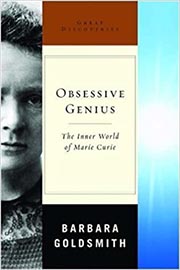Obsessive Genius: The Inner World of Marie Curie
by Barbara Goldsmith
Reviewed January 27, 2005
 If you ask anyone to name a famous female scientist, invariably they will answer "Marie Curie". That is the power of her reputation and legacy. It has been over 100 years since she won her first of two Nobel Prizes (1903 in Physics and 1911 in Chemistry). Best-selling historian Barbara Goldsmith has produced a clear and enjoyable biography that illuminates the life of this enigmatic woman. She offers the reader an accurate portrayal of Marie Curie (1867 - 1934), born Marya Salomee Sklodowska, as a tireless scientist obsessed with her work. She continues into the private life of a woman who battled severe depression, was distanced from her children and challenged the male dominated scientific community.
If you ask anyone to name a famous female scientist, invariably they will answer "Marie Curie". That is the power of her reputation and legacy. It has been over 100 years since she won her first of two Nobel Prizes (1903 in Physics and 1911 in Chemistry). Best-selling historian Barbara Goldsmith has produced a clear and enjoyable biography that illuminates the life of this enigmatic woman. She offers the reader an accurate portrayal of Marie Curie (1867 - 1934), born Marya Salomee Sklodowska, as a tireless scientist obsessed with her work. She continues into the private life of a woman who battled severe depression, was distanced from her children and challenged the male dominated scientific community.
Drawing upon the long-sealed Curie family archives, the book delivers a well-rounded view of Marie Curie. She takes us from her tough childhood in Russian-occupied Poland to finding her soul mate in fellow scientist Pierre Curie to the discoveries of polonium, radium, and radioactivity, thus throwing "open the door to atomic science." Goldsmith focuses her telling more on the social and economic hurdles that Curie had to overcome to manage the roles of scientist, wife, and mother, rather than her scientific life. Goldsmith also shows us the impact of her husband Pierre's untimely death in 1906.
In the end, Marie was made fatally ill by her work with radioactive substances, most notably with radium: "my child," Curie called it. The legacy of Marie Curie makes for a fascinating tale of the family that helped unlock the secrets of the atom and transform our world. This biography is a power portrait of a woman of great passion, genius, and pain of whose impact is still felt in the world.